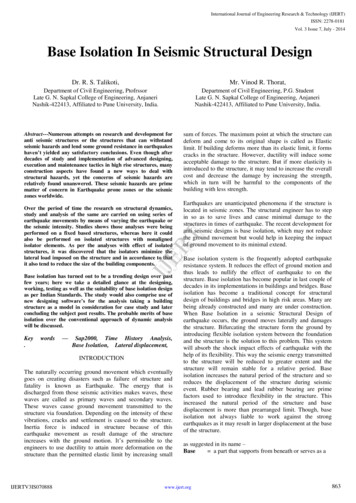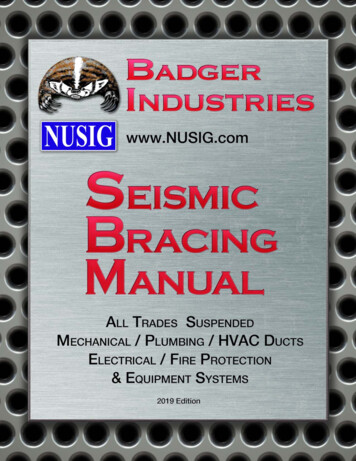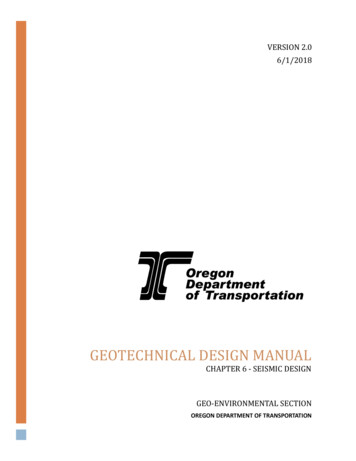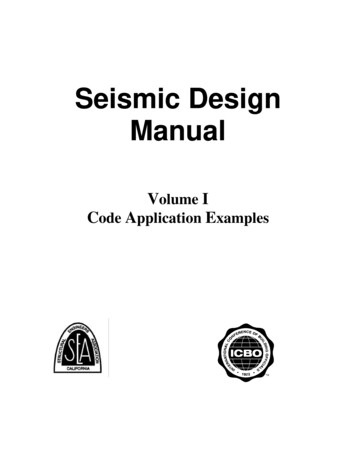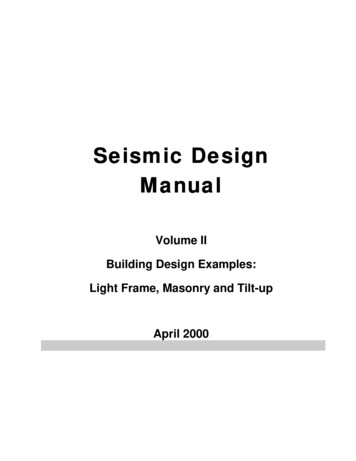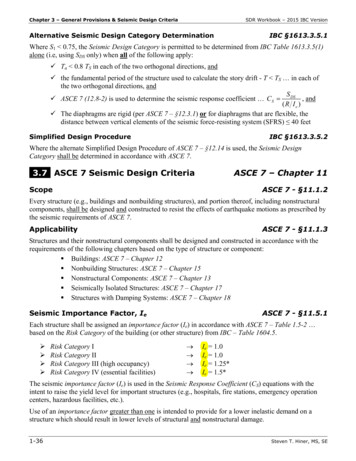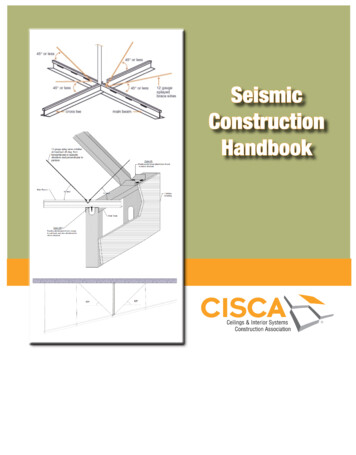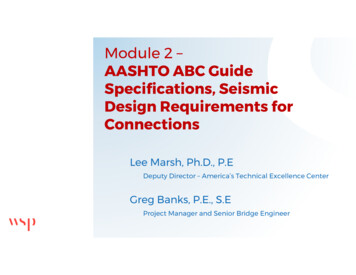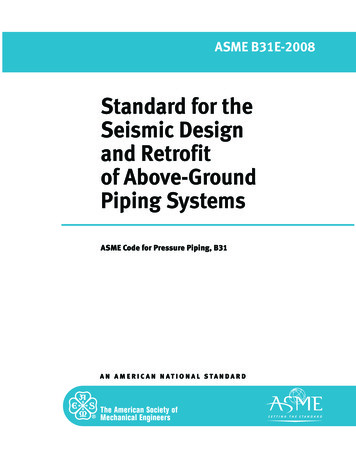
Transcription
ASME B31E-2008Standard for theSeismic Designand Retrofitof Above-GroundPiping SystemsASME Code for Pressure Piping, B31A N A M E R I C A N N AT I O N A L STA N DA R D
ASME B31E-2008Standard for theSeismic Designand Retrofitof Above-GroundPiping SystemsASME Code for Pressure Piping, B31A N A M E R I C A N N AT I O N A L S TA N D A R D
Date of Issuance: July 14, 2008The next edition of this Standard is scheduled for publication in 2011. There will be no addendaissued to this edition.ASME issues written replies to inquiries concerning interpretations of technical aspects of thisStandard. Interpretations are published on the ASME Web site under the Committee Pages athttp://cstools.asme.org as they are issued and will also be published within the next edition of thisStandard.ASME is the registered trademark of The American Society of Mechanical Engineers.This code or standard was developed under procedures accredited as meeting the criteria for American NationalStandards. The Standards Committee that approved the code or standard was balanced to assure that individuals fromcompetent and concerned interests have had an opportunity to participate. The proposed code or standard was madeavailable for public review and comment that provides an opportunity for additional public input from industry, academia,regulatory agencies, and the public-at-large.ASME does not “approve,” “rate,” or “endorse” any item, construction, proprietary device, or activity.ASME does not take any position with respect to the validity of any patent rights asserted in connection with anyitems mentioned in this document, and does not undertake to insure anyone utilizing a standard against liability forinfringement of any applicable letters patent, nor assume any such liability. Users of a code or standard are expresslyadvised that determination of the validity of any such patent rights, and the risk of infringement of such rights, isentirely their own responsibility.Participation by federal agency representative(s) or person(s) affiliated with industry is not to be interpreted asgovernment or industry endorsement of this code or standard.ASME accepts responsibility for only those interpretations of this document issued in accordance with the establishedASME procedures and policies, which precludes the issuance of interpretations by individuals.No part of this document may be reproduced in any form,in an electronic retrieval system or otherwise,without the prior written permission of the publisher.The American Society of Mechanical EngineersThree Park Avenue, New York, NY 10016-5990Copyright 2008 byTHE AMERICAN SOCIETY OF MECHANICAL ENGINEERSAll rights reservedPrinted in U.S.A.
CONTENTSForeword . . . . . . . . . . . . . . . . . . . . . . . . . . . . . . . . . . . . . . . . . . . . . . . . . . . . . . . . . . . . . . . . . . . . . . . . . . . . . .Committee Roster . . . . . . . . . . . . . . . . . . . . . . . . . . . . . . . . . . . . . . . . . . . . . . . . . . . . . . . . . . . . . . . . . . . . .Correspondence With the B31 Committee . . . . . . . . . . . . . . . . . . . . . . . . . . . . . . . . . . . . . . . . . . . . . .Introduction . . . . . . . . . . . . . . . . . . . . . . . . . . . . . . . . . . . . . . . . . . . . . . . . . . . . . . . . . . . . . . . . . . . . . . . . . . .ivvvivii1Purpose . . . . . . . . . . . . . . . . . . . . . . . . . . . . . . . . . . . . . . . . . . . . . . . . . . . . . . . . . . . . . . . . . . . . . . . . . .12Materials . . . . . . . . . . . . . . . . . . . . . . . . . . . . . . . . . . . . . . . . . . . . . . . . . . . . . . . . . . . . . . . . . . . . . . . . .23Design. . . . . . . . . . . . . . . . . . . . . . . . . . . . . . . . . . . . . . . . . . . . . . . . . . . . . . . . . . . . . . . . . . . . . . . . . . . .24Interactions . . . . . . . . . . . . . . . . . . . . . . . . . . . . . . . . . . . . . . . . . . . . . . . . . . . . . . . . . . . . . . . . . . . . . . .55Documentation . . . . . . . . . . . . . . . . . . . . . . . . . . . . . . . . . . . . . . . . . . . . . . . . . . . . . . . . . . . . . . . . . . . .56Maintenance . . . . . . . . . . . . . . . . . . . . . . . . . . . . . . . . . . . . . . . . . . . . . . . . . . . . . . . . . . . . . . . . . . . . . .57References . . . . . . . . . . . . . . . . . . . . . . . . . . . . . . . . . . . . . . . . . . . . . . . . . . . . . . . . . . . . . . . . . . . . . . . .5Tables1Seismic Design Requirements, Applicable Sections . . . . . . . . . . . . . . . . . . . . . . . . . . . . . . . .2Maximum Span, ft (m), Between Lateral Seismic Restraints for Steel Pipe Witha Yield Stress of 35 ksi (238 MPa), in Water Service at 70 F (21 C) . . . . . . . . . . . . . . .iii33
FOREWORDSeismic design of critical piping systems is often required by Building Codes or by regulation,or it may be voluntarily instituted for loss prevention and worker and public safety.While seismic loads are mentioned in the various sections of the ASME B31 Pressure PipingCode, and allowable stresses are provided for occasional loads, there has been a need to providemore explicit and structured guidance for seismic design of new piping systems, as well as retrofitof existing systems. In order to respond to this need, this Standard was prepared by the ASME B31Mechanical Design Technical Committee.This 2008 edition was approved by the American National Standards Institute on April 21, 2008and designated as ASME B31E-2008.iv
ASME B31 COMMITTEECode for Pressure Piping(The following is the roster of the Committee at the time of approval of this Standard.)COMMITTEE OFFICERSM. L. Nayyar, ChairK. C. Bodenhamer, Vice ChairN. Lobo, SecretaryCOMMITTEE PERSONNELR. P. Merrill, Evapco, Inc.J. E. Meyer, Louis Perry & Associates, Inc.E. Michalopoulos, Ministry of Economics of GreeceM. L. Nayyar, Bechtel Power Corp.T. J. O’Grady II, BP Exploration (Alaska)R. G. Payne, Alstom Power, Inc.J. T. Powers, Worley ParsonsE. H. Rinaca, Dominion Resources, Inc.M. J. Rosenfeld, Kiefner & Associates, Inc.R. J. Silvia, Process Engineers and Constructors, Inc.W. J. Sperko, Sperko Engineering Services, Inc.G. W. Spohn III, Coleman Spohn Corp.K. A. Vilminot, Black & VeatchA. L. Watkins, The Perry Nuclear Power PlantP. D. Flenner, Ex-Officio Member, Flenner Engineering ServicesR. W. Haupt, Ex-Officio Member, Pressure Piping EngineeringAssociates, Inc.H. A. Ainsworth, ConsultantR. J. T. Appleby, ExxonMobil Upstream Research Co.C. Becht IV, Becht Engineering Co.A. E. Beyer, Fluor DanielK. C. Bodenhamer, Enterprise Products Co.J. S. Chin, TransCanada Pipeline USD. L. Coym, Worley ParsonsJ. A. Drake, Spectra Energy TransmissionD. M. Fox, Atmos EnergyJ. W. Frey, Stress Engineering Service, Inc.D. R. Frikken, Becht Engineering Co.R. A. Grichuk, Fluor Corp.L. E. Hayden, Jr., ConsultantG. A. Jolly, Vogt Valves Flowserve Corp.W. J. Koves, UOP LLCN. Lobo, The American Society of Mechanical EngineersB31 MECHANICAL DESIGN TECHNICAL COMMITTEEG. D. Mayers, Alion Science & TechnologyT. Q. McCawley, TQM Engineering, PCR. J. Medvick, SwagelokJ. C. Minichiello, Areva NPT. J. O’Grady II, BP Exploration (Alaska)A. W. Paulin, Paulin Research GroupR. A. Robleto, ConsultantE. C. Rodabaugh, Honorary Member, ConsultantM. J. Rosenfeld, Kiefner & Associates, Inc.G. Stevick, Berkeley Engineering & Research, Inc.E. A. Wais, Wais and Associates, Inc.W. J. Koves, Chair, UOP LLCG. A. Antaki, Vice Chair, Becht Nuclear ServicesT. Lazar, Secretary, The American Society of Mechanical EngineersC. Becht IV, Becht Engineering Co.J. P. Breen, Becht Engineering Co.J. P. Ellenberger, ConsultantD. J. Fetzner, BP Exploration Alaska, Inc.J. A. Graziano, Tennessee Valley AuthorityJ. D. Hart, SSD, Inc.R. W. Haupt, Pressure Piping Engineering Associates, Inc.B. P. Holbrook, Babcock Power, Inc.v
CORRESPONDENCE WITH THE B31 COMMITTEEGeneral. ASME Standards are developed and maintained with the intent to represent theconsensus of concerned interests. As such, users of this Standard may interact with the Committeeby requesting interpretations, proposing revisions, and attending Committee meetings. Correspondence should be addressed to:Secretary, B31 Standards CommitteeThe American Society of Mechanical EngineersThree Park AvenueNew York, NY 10016-5990Proposing Revisions. Revisions are made periodically to the Standard to incorporate changesthat appear necessary or desirable, as demonstrated by the experience gained from the applicationof the Standard. Approved revisions will be published periodically.The Committee welcomes proposals for revisions to this Standard. Such proposals should beas specific as possible, citing the paragraph number(s), the proposed wording, and a detaileddescription of the reasons for the proposal, including any pertinent documentation.Interpretations. Upon request, the B31 Mechanical Design Technical Committee will render aninterpretation of any requirement of the Standard. Interpretations can only be rendered in responseto a written request sent to the Secretary of the B31 Standards Committee.The request for interpretation should be clear and unambiguous. It is further recommendedthat the inquirer submit his/her request in the following format:Subject:Edition:Question:Cite the applicable paragraph number(s) and the topic of inquiry.Cite the applicable edition of the Standard for which the interpretation isbeing requested.Phrase the question as a request for an interpretation of a specific requirementsuitable for general understanding and use, not as a request for an approvalof a proprietary design or situation. The inquirer may also include any plansor drawings that are necessary to explain the question; however, they shouldnot contain proprietary names or information.Requests that are not in this format will be rewritten in this format by the Committee priorto being answered, which may inadvertently change the intent of the original request.ASME procedures provide for reconsideration of any interpretation when or if additionalinformation that might affect an interpretation is available. Further, persons aggrieved by aninterpretation may appeal to the cognizant ASME Committee or Subcommittee. ASME does not“approve,” “certify,” “rate,” or “endorse” any item, construction, proprietary device, or activity.Attending Committee Meetings. The B31 Standards Committee regularly holds meetings, whichare open to the public. Persons wishing to attend any meeting should contact the Secretary ofthe B31 Standards Committee.vi
INTRODUCTIONThe ASME B31 Code for Pressure Piping consists of a number of individually publishedSections and Standards, each an American National Standard, under the direction of the ASMECommittee B31, Code for Pressure Piping.Rules for each Standard provide standardized guidance for a specific task found in one ormore B31 Section publications, as follows:(a) B31E, Standard for the Seismic Design and Retrofit of Above-Ground Piping Systems,establishes a method for the seismic design of above-ground piping systems in the scope of theASME B31 Code for Pressure Piping.(b) B31G, Manual for Determining the Remaining Strength of Corroded Pipelines, provides asimplified procedure to determine the effect of wall loss due to corrosion or corrosion-like defectson pressure integrity in pipeline systems.(c) B31J, Standard Test Method for Determining Stress Intensification Factors (i-Factors) forMetallic Piping Components, provides a standardized method to develop the stress intensificationfactors used in B31 piping analysis.This is B31E, Standard for the Seismic Design and Retrofit of Above-Ground Piping Systems.Hereafter, in this Introduction and in the text of this B31 Standard, where the word “Standard”is used without specific identification, it means this B31 Standard. It is expected that this Standardwill be incorporated by reference into the appropriate sections of B31.vii
INTENTIONALLY LEFT BLANKviii
ASME B31E-2008STANDARD FOR THE SEISMIC DESIGN AND RETROFIT OFABOVE-GROUND PIPING SYSTEMS1PURPOSEleak tightness: the ability of a piping system to preventleakage to the environment during or following theearthquake.This Standard establishes a method for the seismicdesign of above-ground piping systems in the scope ofthe ASME B31 Code for Pressure Piping.noncritical piping: piping system other than critical piping that nevertheless must meet the requirements forposition retention.1.1 ScopeThis Standard applies to above-ground, metallic piping systems in the scope of the ASME B31 Code forPressure Piping (B31.1, B31.3, B31.4, B31.5, B31.8, B31.9,B31.11). The requirements described in this Standardare valid when the piping system complies with thematerials, design, fabrication, examination, testing, andinspection requirements of the applicable ASME B31Code section.operability: the ability of a piping system to deliver, control (throttle), or shut off flow during or after the designearthquake.position retention: the ability of a piping system not tofall or collapse in case of design earthquake.seismic design: the activities necessary to demonstratethat a piping system can perform its intended function(position retention, leak tightness, operability, or a combination) in case of design earthquake.1.2 Terms and Definitionsactive components: components that must perform anactive function, involving moving parts or controls during or following the earthquake (e.g., valves, valve actuators, pumps, compressors, and fans that must operateduring or following the design earthquake).seismic function: a function to be specified by the engineering design either as position retention, leak tightness, or operability.seismic interactions: spatial or system interactions withother structures, systems, or components that may affectthe function of the piping system.axial seismic restraint: seismic restraint that acts along thepipe axis.seismic response spectra: a plot or table of accelerations,velocities, or displacements versus frequencies orperiods.critical piping: piping system that must remain leak tightor operable (see definitions) during or following theearthquake.seismic restraint: a device intended to limit seismic movement of the piping system.design earthquake: the level of earthquake for which thepiping system is to be designed for to perform a seismicfunction (position retention, leak tightness, oroperability).seismic retrofit: the activities involved in evaluating theseismic adequacy of an existing piping system and identifying the changes or upgrades required for the pipingsystem to perform its seismic function.ductile piping system: in the context of this Standard forseismic qualification, ductile piping system refers to apiping system where the piping, fitting, and componentsare made of material with a minimum elongation atrupture of 15% at the temperature concurrent with theseismic load.seismic static coefficient: acceleration or force staticallyapplied to the piping system to simulate the effect ofthe earthquake.1.3 Required Inputfree-field seismic input: the ground seismic input at thefacility location.(a) The scope and boundaries of piping systems tobe seismically designed or retrofitted.(b) The applicable ASME B31 Code section.(c) The classification of piping as critical or noncritical, and the corresponding seismic function (positionretention for noncritical systems; degree of leak tightness, operability, or both for critical systems).in-structure seismic input: the seismic excitation within abuilding or structure, at the elevation of the piping system attachments to the building or structure.lateral seismic restraints: seismic restraints that act in adirection perpendicular to the pipe axis.1
ASME B31E-20083.2 Design Method(d) The free-field seismic input (commonly in theform of accelerations) for the design earthquake.(e) The responsibility for developing the in-structureseismic response spectra, where required.(f) The operating conditions concurrent with the seismic load.(g) The responsibility for qualification of the operability of active components, where required.(h) The responsibility for the evaluation of seismicinteractions.(i) The responsibility for as-built reconciliation of construction deviations from the design documents.2The method of seismic design is given in Table 1, anddepends on(a) the classification of the piping system (critical ornoncritical)(b) the magnitude of the seismic input(c) the pipe sizeIn all cases, the designer may elect to seismicallydesign the pipe by analysis, in accordance with para. 3.4.3.3 Design By Rule3.3.1 Where design by rule is permitted in Table 1,the seismic qualification of piping systems may be established by providing lateral seismic restraints at a maximum spacing given by the following:(a) For U.S. Customary unitsMATERIALS2.1 ApplicabilityThis Standard applies to metallic ductile piping systems, listed in the applicable ASME B31 Code section.Lmax p the smaller of 1.94 ⴛ2.2 RetrofitThe seismic retrofit of existing piping systems shalltake into account the condition of the system and itsrestraints. As part of the seismic retrofit, the piping system shall be inspected to identify defects in the pipingor its supports and current and anticipated degradationthat could prevent the system from performing its seismic function.3LTa0.25and 0.01 ⴛ LT ⴛ冪aSya p peak spectral acceleration, largest in any ofthe three directions, including in-structureamplification, gLmax p maximum permitted pipe span between lateral seismic restraints, ftLT p reference span, the recommended spanbetween weight supports, from ASME B31.1,Table 121.5 (reproduced in Table 2), ftSY p material yield stress at operating temperature, psiDESIGN3.1 Seismic LoadingThe seismic loading to be applied may be in the formof horizontal and vertical seismic static coefficients, orhorizontal and vertical seismic response spectra. Theseismic input is to be specified by the engineering designin accordance with the applicable standard (such asASCE 7) or site-specific seismic loading (para. 1.3).The seismic loading shall be specified for each of threeorthogonal directions (typically plant east–west,north–south, and vertical). The seismic design should bebased on either a three-directional excitation, east–westplus north–south plus vertical, combined by square-rootsum of the squares (SRSS), or a two-directional designapproach based on the envelope of the SRSS of theeast–west plus vertical and north–south plus verticalseismic loading.The seismic loading applied to piping systems insidebuildings or structures shall account for the in-structureamplification of the free-field accelerations by the structure. The in-structure amplification may be determinedbased on applicable standards (such as the in-structureseismic coefficient in ASCE 7) or by a facility-specificdynamic evaluation.The damping for design earthquake response spectrum evaluation of piping system shall be 5% of criticaldamping.(b) For SI unitsLmax p the smaller of 1.94 ⴛLTa0.25and 3.33 ⴛ LT ⴛ冪aSya p peak spectral acceleration, largest in any ofthe three directions, including in-structureamplification, gLmax p maximum permitted pipe span between lateral seismic restraints, mLT p reference span, the recommended spanbetween weight supports, from ASME B31.1,Table 121.5 (reproduced in Table 2), mSY p material yield stress at operating temperature, MPaThe maximum span L max between lateral seismicrestraints for steel pipe with a yield stress SY p 35 ksi(238 MPa), in water service, for several values of lateralseismic acceleration a, is provided in Table 2. Longerspans can be developed for gas and vapor service.3.3.2The maximum permitted span length Lmaxshould be reduced by a factor of 1.7 for threaded, brazed,and soldered pipe.2
ASME B31E-2008Table 1 Seismic Design Requirements, Applicable SectionsNoncritical PipingCritical PipingAccelerationNPS (DN) 4 (100)NPS (DN) 4 (100)NPS (DN) 4 (100)NPS (DN) 4 (100)a 0.3 gNRsection 4 (interactions)NRsection 4 (interactions)DRpara. 3.3 (rule)para. 3.6 (mech. joints)para. 3.7 (restraints)section 4 (interactions)DApara. 3.4/3.5 (analysis)para. 3.6 (mech. joints)para. 3.7 (restraints)para. 3.8 (components)section 4 (interactions)a 0.3 gNRsection 4 (interactions)DRpara. 3.3 (rule)para. 3.6 (mech. joints)para. 3.7 (restraints)section 4 (interactions)DApara. 3.4/3.5 (analysis)para. 3.6 (mech. joints)para. 3.7 (restraints)para. 3.8 (components)section 4 (interactions)DApara. 3.4/3.5 (analysis)para. 3.6 (mech. joints)para. 3.7 (restraints)para. 3.8 (components)section 4 (interactions)aDADRNPSNRppppppeak spectral acceleration, largest in any of the three directions, including in-structure amplification, gdesign by analysisdesign by rulenominal pipe size, in.explicit seismic analysis is not required, provided the piping system complies with the provisions of the applicableASME B31 Code section, including design for loading other than seismicTable 2 Maximum Span, ft (m), Between Lateral Seismic Restraints for Steel Pipe With a Yield Stress of35 ksi (238 MPa), in Water Service at 70 F (21 C)Maximum Span, ft (m)NPS (DN)LT, ft )(5.1)(5.7)(6.9)(8.1)(9)(9.6)0.1 4)(19.5)(23.7)(27.9)(30.9)(33)0.3 5)(18)(21)(23.4)(25.2)3.3.3Straight pipe runs longer than three timesthe span of Table 2 should be restrained longitudinally.1.0 8)(13.2)(15.6)(17.4)(18.6)2.0 11.1)(13.2)(14.4)(15.6)3.0 g9 (2.7)13 (3.9)15 (4.5)18 (5.4)22 (6.6)25 (7.5)30(9)35 (10.5)39 (11.7)42 (12.6)3.3.7 The effect of seismic restraints on the expansion and contraction flexibility of the piping system shallbe verified in accordance with the design rules of theapplicable ASME B31 Code section.3.3.4The piping system should be evaluated tobe sufficiently flexible to accommodate the differentialmovement of attachment points to the structure or themovement of equipment or headers to which the pipingis attached. This evaluation may be achieved by calculating the predicted seismic plus concurrent loads movement of the structure, equipment, or header to whichthe pipe is connected, and verifying that the pipe spanshave sufficient flexibility to sustain these movements.3.3.8The designer shall identify degradation inthe piping or its supports and current and anticipateddegradation that could prevent the system from performing its seismic function.3.4 Design by Analysis3.3.5 The distance between seismic restraintsshould be reduced for pipe spans that contain heavyin-line components.Where design by analysis is required in Table 1, orwhere it is applied by the designer as an alternative tothe rules of para. 3.3, the elastically calculated longitudinal stresses due to the design earthquake (calculated3.3.6 Unrestrained cantilevered pipe shall be evaluated on a case-by-case basis.3
ASME B31E-2008by static or dynamic analysis) shall comply with thefollowing equations:concrete, shall be calculated by static or dynamic analysis, and added to concurrent operating loads.PD MseismicM 0.75i sustained4tZ min [2.4S; 1.5SY; 60 ksi (408 MPa)]3.7.2The seismic adequacy of seismic restraintsshall be determined on the basis of vendor catalogs, andthe applicable design method and standard, such asMSS SP-58 or MSS SP-69 for standard support components, AISC or AISI for steel members, and ACI forconcrete anchor bolts. The qualification of seismicrestraints shall also address the prevention of buckling.FSAM SYAA p pipe cross-sectional area, deductingcorrosion/erosion allowance but notmill toleranceD p outside pipe diameterFSAM p resultant force (tension plus shear) dueto seismic anchor motioni p stress intensification factor, from theapplicable ASME B31 Code section,0.75i cannot be less than 1Mseismic p elastically calculated resultant momentamplitude due to seismic load, including inertia and relative anchor motionMsustained p elastically calculated resultant momentamplitude due to sustained loads concurrent with the seismic loadP p system operating pressureS p ASME B31 allowable stress, at the normal operating temperature; forASME B31.4, use 0.80 S Y, forASME B31.8, use FTSY where F p location factor, T p temperature deratingfactor, as defined in B31.8SY p specified minimum yield stress of thematerial (SMYS) at the normaloperating temperaturet p pipe wall thickness, deducting corrosion allowance but not mill toleranceZ p pipe section modulus, deducting corrosion/erosion allowance but not mill tolerance, in.33.7.3The seismic adequacy of nonseismicrestraints shall also be verified if they are expected toperform a function after the earthquake. For example,spring hangers should not be permitted to pull off thewall if they are necessary to support the pipe weightafter the earthquake.3.7.4 For lateral seismic restraints, a total diametricgap equal to 1 2 in. (12 mm) is acceptable. A gap up to0.1D or 2 in. (50 mm), whichever is smaller, is permitted,provided the seismic load, calculated on the basis ofzero gap, is multiplied by an impact factor of 2. Largergaps or smaller impact factors may be justified by analysis or test.3.7.5 Short rod hangers [typically less than 12 in.(300 mm) long] may provide a restoring force that tendsto limit side-sway of hung pipe, and may be consideredas seismic restraints, provided they are designed to sustain the seismic loads and movements.3.8 Equipment and ComponentsThe seismic and concurrent loads applied by the pipeat equipment and component nozzles shall be qualifiedas part of the seismic design or retrofit of the pipingsystem, to a degree commensurate with the requiredsystem function, as specified in para. 1.3.For position retention, it is usually sufficient to showthat the piping loads on equipment and componentswill not cause rupture. For leak tightness, the stress shallbe maintained within yield or shown not to cause fatigueruptures. For operability, the piping loads shall be keptwithin operability limits established by detailed analysis, testing, or similarity to seismically qualified equipment or components.Components with unsupported extended structures,such as valves with heavy motor operators, shall beevaluated to insure that the extended structure doesnot fail during a seismic event. For components withunsupported extended structures, a natural frequencycheck shall be performed and shall be greater than33 cps. When the natural frequency is less than 33 Hz,the component extended structure shall be stiffened asrecommended by the component manufacturer.3.5 Alternative Design MethodsThe piping system may be qualified by more detailedanalysis techniques, including fatigue, plastic, or limitload analysis.3.6 Mechanical JointsFor critical piping systems, the movements (rotations,displacements) and loads (forces, moments) at mechanical joints (nonwelded, nonbrazed, and nonsolderedjoints) shall remain within the failure limits (for positionretention) or leak tightness limits (for leak tightness andoperability) specified by the owner.3.7 Seismic Restraints3.7.1 The seismic load on seismic restraints andtheir attachment to building structures or anchorage to4
ASME B31E-20084INTERACTIONSPublisher: American Iron and Steel Institute (AISI),1140 Connecticut Ave., NW, Washington, DC 20036Piping systems shall be evaluated for seismic interactions. Credible and significant interactions shall be identified and resolved by analysis, testing, or hardwaremodification.5ASCE 7, Minimum Design Loads for Buildings andOther StructuresPublisher: American Society of Civil Engineers (ASCE),1801 Alexander Bell Drive, Reston, VA 20191DOCUMENTATIONASME B31.1, Power PipingThe engineering design shall specify the documentation to be submitted by the designer.ASME B31.3, Process Piping6ASME B31.5, Refrigerant Piping and Heat TransferComponentsASME B31.4, Pipeline Transportation Systems for LiquidHydrocarbons and Other LiquidsMAINTENANCEThe piping system shall be maintained in a conditionthat meets the seismic design requirements for theoperating life of the system. In particular, changes tolayout, supports, components, or function, as well asmaterial degradation in service shall be evaluated toverify the continued seismic adequacy of the system.7ASME B31.8, Gas Transmission and Distribution PipingSystemsASME B31.9, Building Services PipingASME B31.11, Slurry Transportation Piping SystemsPublisher: The American Society of MechanicalEngineers (ASME), Three Park Avenue, New York,NY 10016; Order Department: 22 Law Drive,P.O. Box 2300, Fairfield, NJ 07007-2300REFERENCESThe following is a list of publications referenced inthis Standard. The latest edition shall apply.ICBO AC156, Acceptance Criteria for the SeismicQualification Testing of Nonstructural ComponentsPublisher: International Conference of Building Officials(ICBO), ICC Evaluation Service, 5360 Workman MillRoad, Whittier, CA 90601ACI 318 Building Code Requirements for ReinforcedConcretePublisher: American Concrete Institute (ACI),38800 Country Club Drive, Farmington Hills, MI48331MSS SP-58, Pipe Hangers and Supports—Materials,Design, and ManufactureAISC, Manual of Steel ConstructionPublisher: American Institute of Steel Construction(AISC), One East Wacker Drive, Chicago, IL60601-1802MSS SP-69, Pipe Hangers and Supports—Selection andApplicationPublisher: Manufacturers Standardization Society of theValves and Fittings Industry, Inc. (MSS), 127 ParkStreet NE, Vienna, VA 22180AISI, Specification for the Design of Cold-Formed SteelStructural Members5
INTENTIONALLY LEFT BLANK6
ASME CODE FOR PRESSURE PIPING, B31Power Piping . . . . . . . . . . . . . . . . . . . . . . . . . . . . . . . . . . . . . . . . . . . . . . . . . . . . . . . . . . . . . . . . . . . . . . . . . . . . . . . . . . . . . . . . . . . . . . . B31.1-2007Fuel Gas Piping
the ASME B31 Code for Pressure Piping. 1.1 Scope This Standard applies to above-ground, metallic pip-ing systems in the scope of the ASME B31 Code for Pressure Piping (B31.1, B31.3, B31.4, B31.5, B31.8, B31.9, B31.11). The requirements described in this Standard are valid when the piping system complies with the



